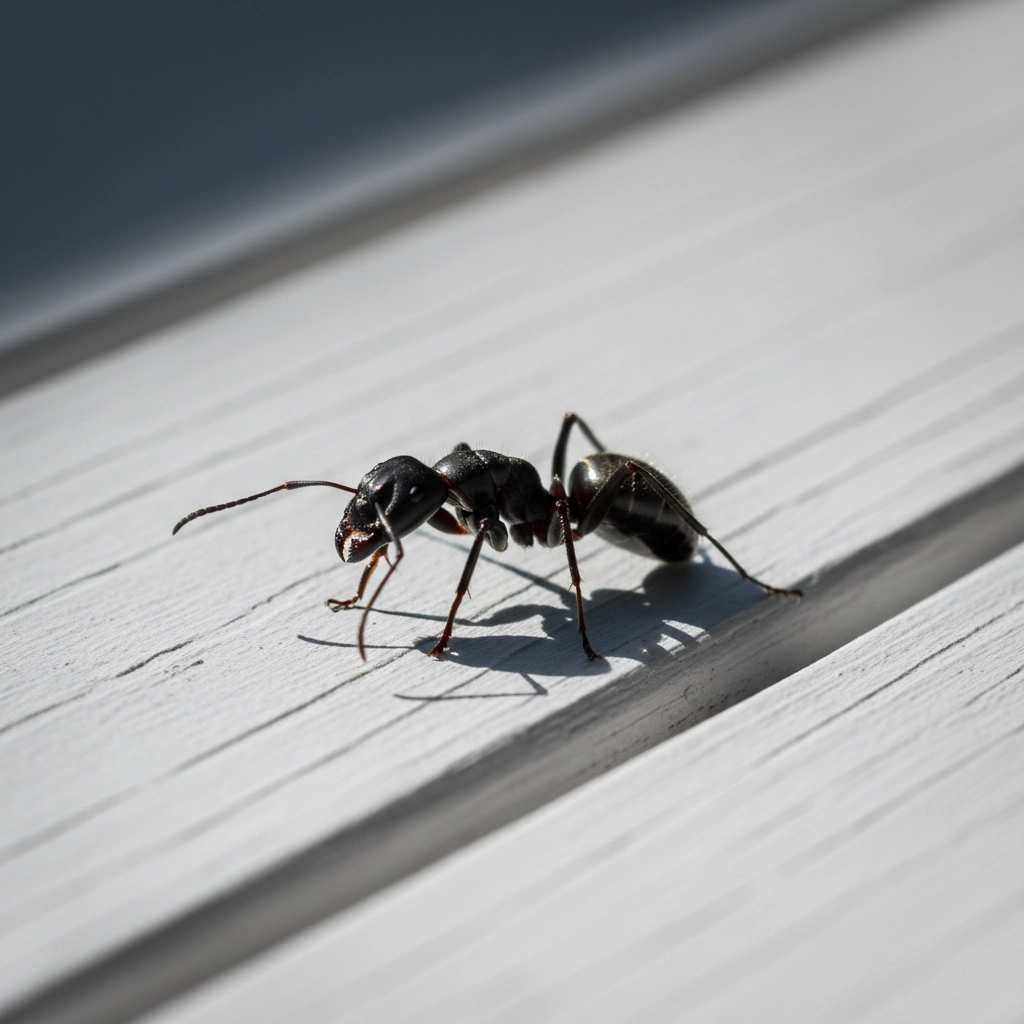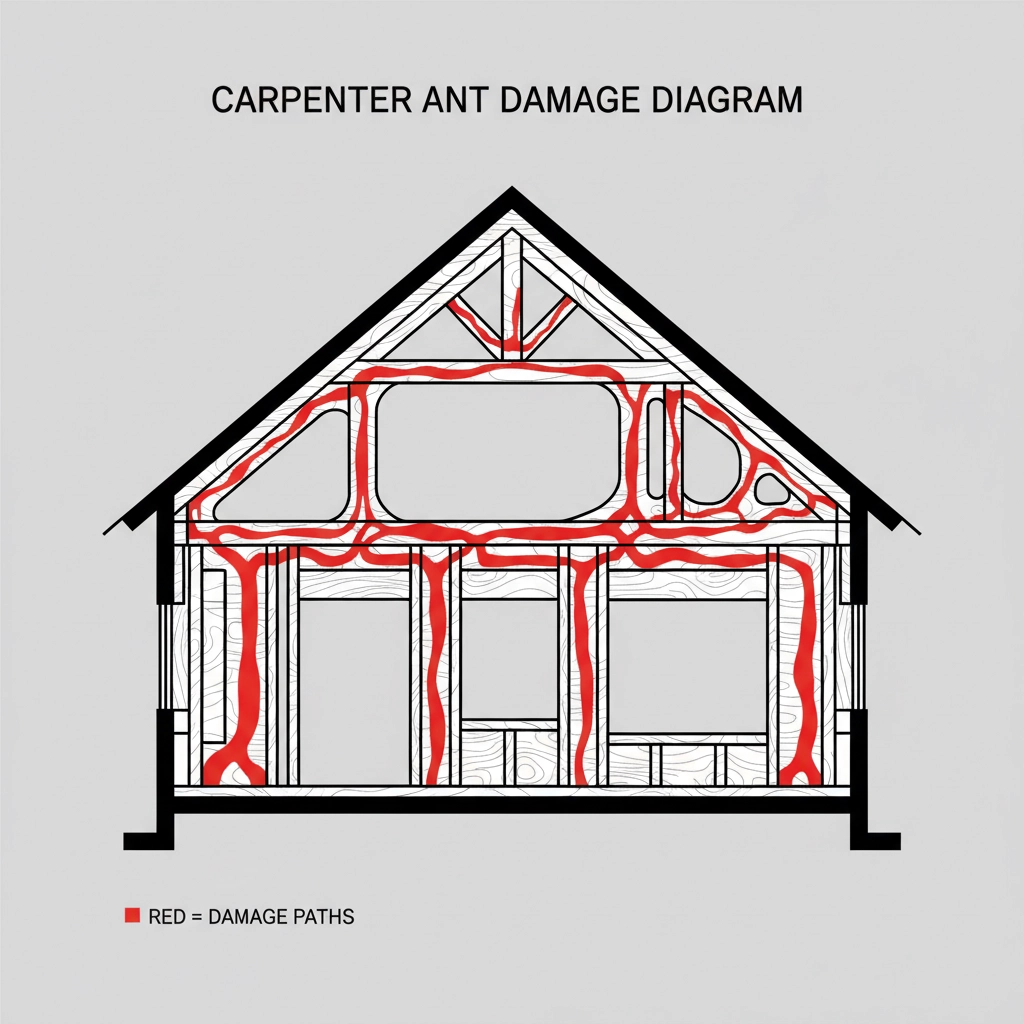Ants in Haliburton County: How to Spot, Prevent, and Get Rid of These Common Pests
- Targeted Wildlife and Pest Solutions

- Sep 26
- 5 min read
If you own property in Haliburton County, you've likely encountered ants at some point. These industrious insects are more than just a minor inconvenience: some species can cause real damage to your home or cottage. Understanding what you're dealing with and how to handle ant problems effectively will save you time, money, and frustration down the road.
The Ants You'll Find in Haliburton County
Carpenter Ants are your biggest concern in this region. These large, jet-black ants can reach up to half an inch in length and have a distinctive shiny appearance. Unlike termites, carpenter ants don't eat wood: they excavate it to build their nests. You'll find them particularly active around decaying logs, wooden structures, and areas with moisture problems. They prefer softwood and wood that's already been damaged by water or other insects.
Pavement Ants are another common sight around Haliburton properties. These small, dark brown to black ants build their colonies under driveways, sidewalks, and patios. You'll notice small dirt mounds around cracks in concrete: that's usually your first sign of a pavement ant colony nearby.

Odorous House Ants frequently make their way indoors, especially during cooler months. These tiny, dark ants emit a distinctive rotten coconut smell when crushed. They're particularly drawn to sweet substances and will relocate their nests frequently, making them tricky to eliminate completely.
Field Ants build large mounds in open areas of your property. While they typically stay outdoors, they can become problematic when their colonies grow large or when they start farming aphids on your plants.
How to Spot an Ant Infestation
Look for ant trails. You'll see organized lines of ants moving between their nest and food sources. These trails often follow edges of walls, countertops, or outdoor structures.
Check for physical signs. Small dirt mounds near your foundation, driveway cracks, or garden areas indicate active colonies. For carpenter ants, look for small piles of wood shavings near wooden structures: this sawdust-like material means they're actively excavating.
Listen carefully. Carpenter ant colonies can sometimes be heard rustling inside walls, especially at night when they're most active.
Monitor seasonal patterns. Most ants become more active in spring and summer, but some species remain active year-round in heated buildings.
Inspect moisture-prone areas. Check around leaky pipes, poorly ventilated areas, and anywhere water damage has occurred. Carpenter ants are particularly attracted to these spots.
The Real Risks of Ant Infestations
Structural damage poses the most serious threat. Carpenter ants can weaken wooden structures over time by creating extensive tunnel systems. While they work more slowly than termites, a large colony can compromise support beams, floor joists, and window frames. This damage often goes unnoticed until it becomes extensive and expensive to repair.
Health concerns are generally minimal with most ant species, but they can contaminate food sources and surfaces as they forage. Ants that have been crawling through garbage, pet waste, or other unsanitary areas can spread bacteria to your kitchen counters and food storage areas.
Secondary pest problems often develop when ants farm aphids or scale insects on your plants. This relationship can damage your landscaping and create additional pest management challenges.
Property value impacts become significant when structural damage occurs or when infestations become severe enough to require professional remediation and repairs.

Prevention: Your First Line of Defense
Eliminate moisture sources around your property. Fix leaky pipes, improve ventilation in basements and crawl spaces, and ensure proper drainage around your foundation. Clean out gutters regularly and repair any roof leaks promptly.
Remove food attractants by storing dry goods in sealed containers, cleaning up crumbs and spills immediately, and securing garbage in tight-fitting containers. Don't leave pet food out overnight, and clean pet food bowls regularly.
Maintain your landscape by trimming bushes and tree branches away from your house, removing dead wood and stumps, and avoiding overwatering plants near your foundation. Keep firewood stored away from your home and elevated off the ground.
Seal entry points by caulking cracks around windows, doors, and your foundation. Install door sweeps and repair damaged screens. Pay special attention to areas where utilities enter your home.
Regular inspections help you catch problems early. Check wooden structures for signs of damage, monitor areas where you've seen ants before, and look for new ant trails during your routine property maintenance.
What to Do If You Have Ants
Start with identification. Different ant species require different approaches, so determine what type you're dealing with before taking action.
Follow the trail to locate entry points and potential nest sites. Don't immediately kill the ants you see: they'll lead you to the source of the problem.
Use targeted treatments for the specific species you've identified. Bait stations work well for most house-invading ants because worker ants carry the bait back to the colony, eliminating the entire nest.

Clean thoroughly to remove pheromone trails that guide other ants to food sources. Use a mixture of white vinegar and water on hard surfaces to disrupt these chemical signals.
Address the root cause by eliminating whatever attracted the ants initially. This might mean fixing a moisture problem, removing food sources, or cleaning up outdoor debris.
Natural and Chemical Solutions
Diatomaceous earth provides a natural option that's safe around children and pets. Sprinkle food-grade diatomaceous earth around entry points and ant trails. This fine powder damages ant exoskeletons and dehydrates them.
Boric acid baits work effectively for many ant species but require careful handling around households with children or pets. The ants carry the bait back to their colonies, eliminating the entire population.
Commercial ant sprays provide immediate knockdown of visible ants but don't address the colony itself. Use these as part of a comprehensive approach, not as your only solution.
Professional-grade baits often prove more effective than consumer products because they're specifically formulated for different ant species and contain more attractive bait matrices.
When to Call Professionals
Carpenter ant infestations almost always require professional treatment due to the potential for structural damage. These colonies can be extensive and difficult to locate completely.
Multiple species problems become complex to manage when you're dealing with several different types of ants simultaneously.
Recurring infestations indicate that you haven't addressed the underlying causes or eliminated the colonies completely.
Large-scale problems affecting multiple areas of your property typically need professional assessment and treatment to achieve long-term control.
Structural concerns require professional inspection when you suspect carpenter ants have caused damage to load-bearing elements of your home.
At Targeted Wildlife and Pest Solutions, we understand the unique challenges that Haliburton County property owners face with ant infestations. Our experience with local ant species and their behaviors helps us develop effective, targeted treatment strategies that address both immediate problems and long-term prevention.
Taking action early prevents small ant problems from becoming major infestations. Regular monitoring, proper maintenance, and prompt treatment when needed will keep your property ant-free and protect your investment for years to come.
Comments